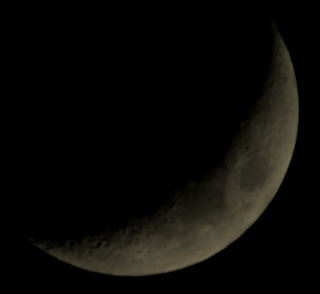March 31st 0715 GMT Sun
March 27th 2000 GMT Melotte 111
March 27th 1200 GMT Sun
I bin scanned the Sun using my filters.
The sunspot pattern had changed again and one was especially large.
March 26th 0800 GMT Sun
I bin scanned the Sun with my filters and
found that the sunspots had rotated and changed shape.
March 25th 0725 GMT Moon
March 24th 1200 GMT Sun
There were a few clear days but, unfortunately, there had
not been any sunspots since March 14th. New activity rotated on and
I saw a sunspot in my binoculars and filters.
March 23rd 0550 GMT Moon and Venus
The Moon was waning gibbous and low in
the west. I snapped it with my DSLR at 300mm focal length, ISO 100 and 1/500
second exposure.
I also snapped Venus at 300mm focal length, ISO 100 and 1/320 second exposure.
March 22nd 2000 GMT Constellations and Disaster
My plan was an hours worth of shots in the direction of Leo. However, the connection on my intervalometer broke off and I was unable to use it. I took a few frames manually instead.
I caught a meteor on my 2nd frame.
A few frames stacked to show Leo and some surrounding stars.
March 20th 2100 GMT Meteor Hunt and Constellation Shoot
There was a short period of darkness
between dusk and moonrise. I aimed my camera at Gemini and Canis Minor in
hope... I used 18mm focal length, ISO 6400 and 6 seconds exposure.
At 2124 GMT, I caught a short, but bright, meteor trail in Orion.
The constellation shots were marred by dirty lenses and, perhaps, suggested that there was a lot of sensor cleaning to do. On the other hand., by cropping out affected areas, the first set of 40 images showed a decent Gemini.
The second set of images produced a wider field. It also showed Canis Minor and Cancer.
March 19th 2100 Moon and Betelguese
March 18th 2110 GMT Moon
March 18th 1900 GMT Betelguese
It was mid-dusk but some of the
constellations were visible. The Moon was low but bright, being just past full.
As most comparison stars were visible, I estimated the brightness of Betelguese
at magnitude 0.3.
March 17th 0800 GMT Sun
Although there
were some sunspots on the professional observatory images, they had faded and I
could not detect them with my binoculars and filters.
March 16th 2140 GMT Moon
The Moon was
high in the sky and nearly full. Few stars were visible, despite the lack of
clouds. There was only one sensible visual or photographic target, namely – the
Moon. I took a few shots at 300mm focal length., ISO 100 and 1/250 second
exposure with my DSLR.
March 15th 0605 GMT Venus
I hadn’t got a good shot pf Venus in
recent weeks but it hard with a DSLR, even with a zoom lens. It is like trying
to photograph the Moon with a 10mm lens. I took multiple exposures at 300mm
focal length, ISO 100 and 1/320 second exposure.
March 14th 1915 GMT Moon
March 14th 1620 GMT Moon
The evening forecast was less than
encouraging, so I took some shots of the waxing gibbous moon at 300mm focal
length, ISO 400 and 1/500 second exposure.
March 14th 1200 GMT Sun
March 13th 2050 GMT Moon
March 12th 1255 GMT Sun
March 12th 1430 GMT Sun
I bin scanned the Sun in poor conditions and saw a single, large sunspot.
March 10th 0640 GMT Venus
I took a look
at Venus with my binoculars in the dawn sky. The phase appeared to be a thick
crescent, with a 45% phase, but the apparent size was quite small as the planet
retreated from Earth.
March 8th 0610 GMT Venus
Venus was low in the dawn sky. Through my camera viewfinder, it looked like a thick crescent phase. I snapped it with my DSLR at 300mm focal length, ISO 100 and 1/200 second exposure.
March 7th 2025 GMT Moon
I snapped the Moon in full darkness at
300mm focal length, ISO 100 and 1/200 second exposure. I did not get the focus
I was hoping for but managed a half-decent shot after processing.
March 6th 1650 GMT Moon
I photographed the Moon with my DSLR at
300mm focal length, ISO 400 and 1/200 second exposure. Honestly, it was
overexposed but processing sorted it out.
March 4th 2300 GMT Constellation and Meteor Shoot
After a cloudy afternoon and evening, it
finally cleared. I aimed my camera at Bootes.
The second set of frames showed Corona Borealis in addition to Bootes and Coma Berenices.
The third set of frames was similar.
As was the fourth.
The fifth was more clear.
For the 6th set of images, Coma Berenices was climbing from the murk near the horizon but was also getting close to the edge of the field of view.
Another set of images left Coma Berenices just visible at the edge of the view.
On the next one, only Bootes and Corona Borealis were shown in full.
The next one was clearer.
The next was similar.
The next one showed a good part of Hercules as well.
As did the next.
The final shot caught all of Hercules.













































